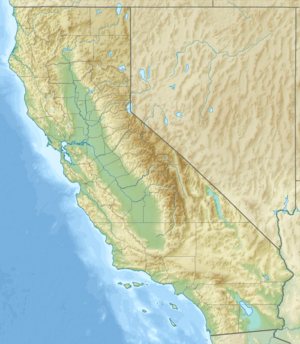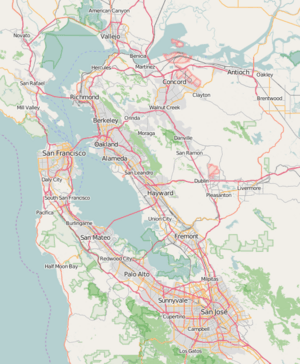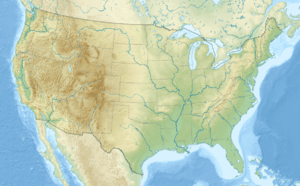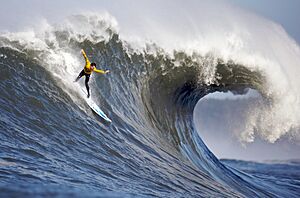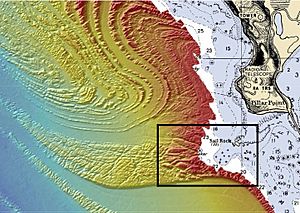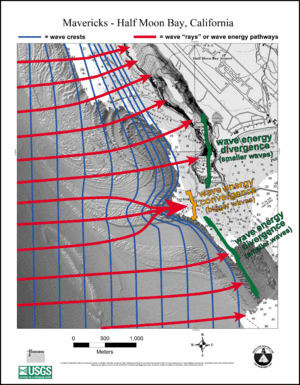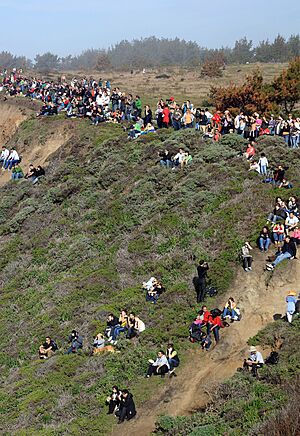Mavericks, California facts for kids
Quick facts for kids Mavericks |
|
|---|---|
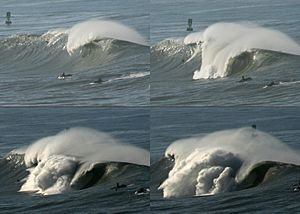
4-frame image that shows the famous break of Mavericks
|
|
| Location | Pillar Point Harbor, California |
| Coordinates | 37°29′29″N 122°30′30″W / 37.49149°N 122.508338°W |
| Geology | Surf break |
Mavericks is a surfing location in northern California outside Pillar Point Harbor, just north of the town of Half Moon Bay at the village of Princeton-by-the-Sea. After a strong winter storm in the northern Pacific Ocean, waves can routinely crest at over 25 ft (8 m) and top out at over 60 ft (18 m). Routinely, waves that break can be recorded on seismometers. The break is caused by an unusually shaped underwater rock formation.
Mavericks is a winter destination for some of the world's best big wave surfers. From 1999 to 2016, an invitation-only contest called the Titans of Mavericks was held there during most winter surfing seasons, whenever the winter wave conditions there were deemed to be suitable to meet the needs of the contest.
Contents
Origin of the name
In early March 1967, Alex Matienzo, Jim Thompson, and Dick Notmeyer surfed the distant waves of Pillar Point. With them was Matienzo's roommate's white-haired German Shepherd, Maverick, who was accustomed to swimming with his owner and Matienzo while they were surfing. The three surfers left Maverick on shore, but he swam out to them. Finding the conditions unsafe for the dog, Matienzo tied him up before rejoining the others. The riders had limited success that day as they surfed overhead peaks about 1⁄4 mi (400 m) from shore, just along the rocks that are visible from shore; they deemed the bigger outside waves too dangerous. The surfers named the location after Maverick, who seemed to have gotten the most pleasure from the experience.
Description
Sea floor
Sea-floor maps released by the US National Oceanic and Atmospheric Administration in 2007 revealed the mechanisms behind Mavericks' waves. A long, sloping ramp leads to the surface. The ramp slows the propagation of the wave over it. The wave over the deep troughs on each side of the ramp continues at full speed forming two angles in the wavefront centered over the boundaries between the ramp and the troughs. The result of this is a U-shaped or V-shaped wavefront on the ramp that contains the wave energy from the full width of the ramp. This U-shaped or V-shaped wave then collapses into a small area at the top center of the ramp with tremendous force.
Left Hander
The left at Mavericks is rarely ridden, as the wave tends to be unreliable. It can be a much faster ride than the right, shooting riders down a quicker pipe barrel. Surfline says the left is "a short-lived explosion of hell and spitfire."
History
Jeff Clark grew up in Half Moon Bay, watching Mavericks from Half Moon Bay High School and Pillar Point. At that time the location was thought too dangerous to surf. He conceived the possibility of riding Hawaii-sized waves in Northern California. In 1975 at age 17 and with the waves topping out at 20–24 ft (6–7.5 m), Clark paddled out alone to face the break. He caught multiple left-breaking waves, thereby becoming the first documented person to tackle Mavericks head-on.
Other than a few of Clark's friends who had paddled out and had seen Mavericks for themselves, no big wave surfers believed in its existence. Popular opinion held that there simply were no large waves in California.
Dave Schmidt (brother of big wave legend Richard Schmidt) and Tom Powers, both from Santa Cruz, were two of the next people to surf at Mavericks, surfing with Clark on January 22, 1990. John Raymond, from Pacifica, Johathan Galili, from Tel Aviv, Israel, and Mark Renneker, from San Francisco, surfed Mavericks a few days later.
Popularization
In 1990, a photo of Mavericks taken by Clark's friend Steve Tadin was published in Surfer magazine, generating interest in Mavericks. More photos of Mavericks appeared in surfing magazines, and before long, filmmaker Gary Medeiros released a movie, Waves of Adventure in the Red Triangle. As news of Mavericks spread, many big-wave surfers came and surfed there.
Death of Mark Foo
On December 23, 1994, during a week of huge swells, notable Hawaiian big-wave riders Mark Foo, Ken Bradshaw, Brock Little, Mike Parsons, and Evan Slater visited Mavericks. In the late morning, Foo rode on a late takeoff into an 18 ft (5.5 m) wave, caught the edge of his surfboard on the surface, and fell forward into a wipe out near the bottom of the wave. A few hours later, a fellow surfer traveling back to shore on a boat noticed a body in the water, which was identified as Foo. The only visible injury was a small cut on the forehead. Many surfers believe that the fall knocked the wind out of Foo and he was tied down by his leash to a rock formation.
News of Foo's death traveled quickly to the far reaches of the surfing community. The accident afforded Mavericks greater notoriety and prompted the formation of the Mavericks Water Patrol by Frank Quirarte and Clark. The accident also triggered a continuing discourse around the safe use of surfboard leashes while surfing extreme waves. Many believed that Foo's surfboard leash may have contributed to his death. Leash proponents defend it as a useful convenience and as insurance against losing the surfboard, a form of flotation device, a means for a fallen surfer to find the surface by following the leash cord to the buoyant board. Opponents argue that a leash can cause the rider to collide with his board in a wipe out and that the leash can also loop around the surfer's arms, legs or the neck when underwater. Quick-release velcro leashes have since become standard surfing equipment to address some of these risks.
Death of Sion Milosky
Sion Milosky, an accomplished big-wave surfer, died at Mavericks on March 16, 2011. Milosky, 35, of Kalaheo, Kauai, Hawaii, apparently drowned after enduring a two-wave hold down around 6:30 PM. Twenty minutes after the incident, Nathan Fletcher found Milosky's body floating at the Pillar Point Harbor mouth.
Milosky had been named the North Shore Underground Surfer of the Year in February 2011. He used some of his $25,000 prize to travel to Half Moon Bay to catch one of the last big swells of the season at Mavericks.
Women at Mavericks
In 1999, Sarah Gerhardt became the first woman to surf Mavericks. In 2018, after a long fight, women were first included in the formal Titans of Mavericks surf competition, also receiving equal prize money.
Invitational Surfing Contest
The first surfing contest at Mavericks was held in 1999, as the Mavericks Invitational. The competition later came to be known as the Titans of Mavericks invitational. Organizers would invite a number big wave surfers annually to compete in the one-day event, but it was only held if wave conditions were favorable during the competition season (which season ran from November 1-March 31). In 2019, after two years straight of cancelled competitions, the World Surf League announced that the contest had been canceled indefinitely, citing "various logistical challenges" and "the inability to run the event the last two seasons." The competition has not been held since.
The Mavericks Awards is, as of 2022 a new video performance contest where big wave surfers and videographers submit their best surf content of Mavericks each season. There are 3 categories for men and 3 categories for women include Biggest Wave, Ride of the Year, and Performer of the Year.
See also
- List of surfing records


